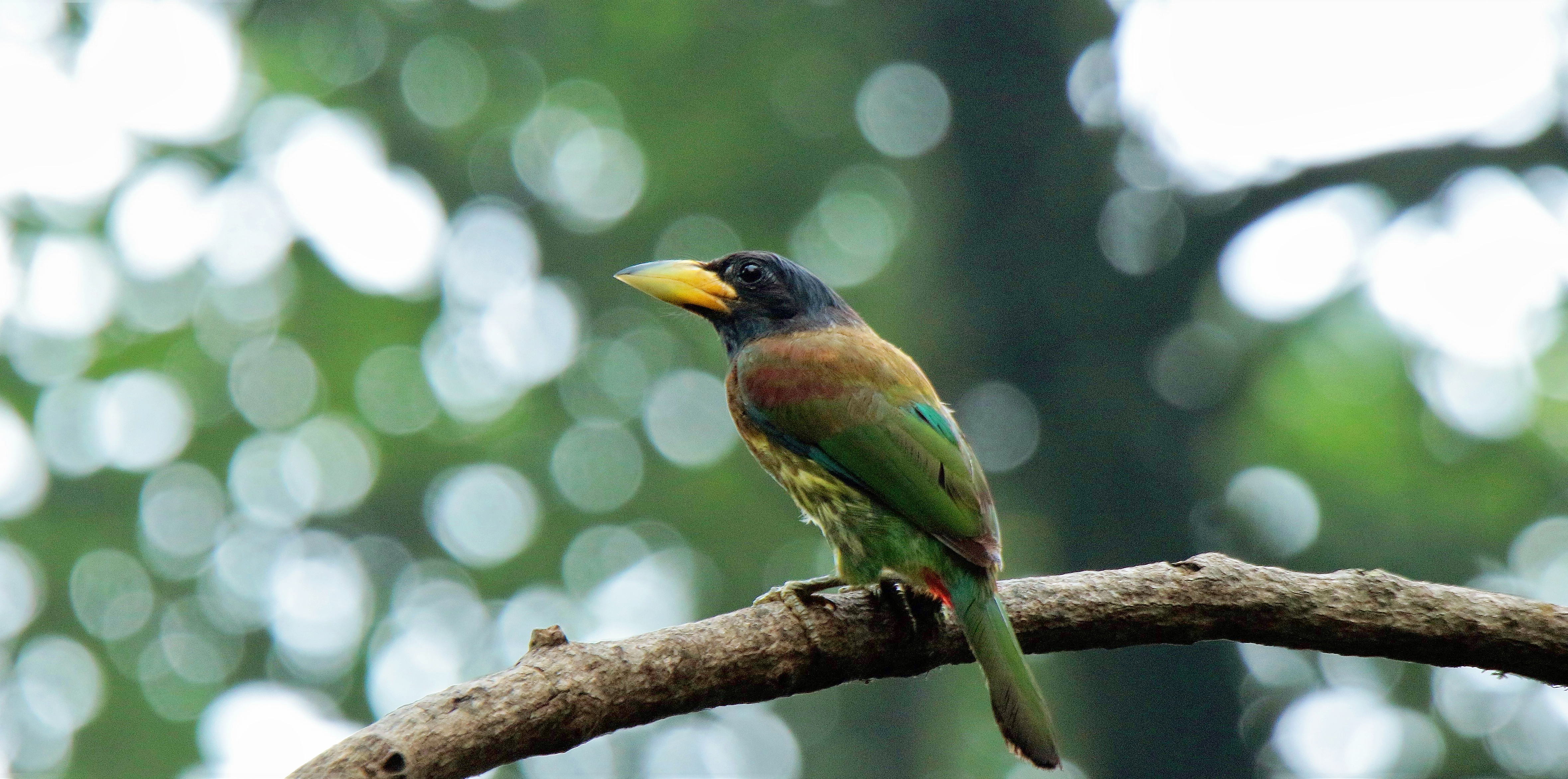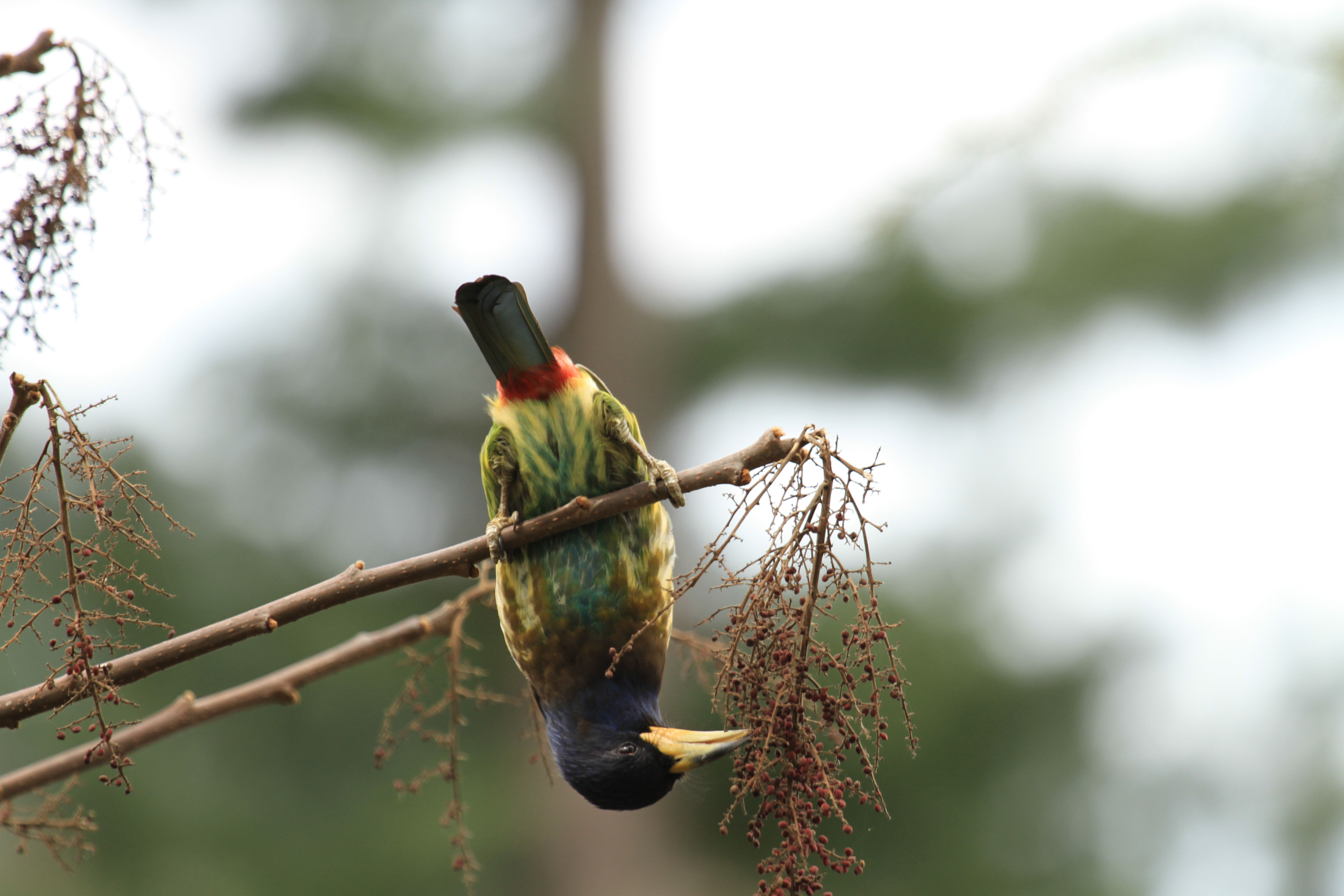Great Barbet on:
[Wikipedia]
[Google]
[Amazon]
The great barbet (''Psilopogon virens'') is an
 ''Bucco virens'' was the
''Bucco virens'' was the
 The great barbet has a blue head, large yellow bill, brown and green-streaked body, belly and a red vent. The
The great barbet has a blue head, large yellow bill, brown and green-streaked body, belly and a red vent. The

 The great barbet is a resident breeder in the lower-to-middle altitudes of the
The great barbet is a resident breeder in the lower-to-middle altitudes of the
Asian barbet
The Asian barbets are a family of bird species, the Megalaimidae, comprising two genera with 35 species native to the forests of the Indomalayan realm from Tibet to Indonesia. They were once clubbed with all barbets in the family Capitonidae bu ...
native to the Indian sub-continent
The Indian subcontinent is a physiographical region in Southern Asia. It is situated on the Indian Plate, projecting southwards into the Indian Ocean from the Himalayas. Geopolitically, it includes the countries of Bangladesh, Bhutan, India ...
and Southeast Asia
Southeast Asia, also spelled South East Asia and South-East Asia, and also known as Southeastern Asia, South-eastern Asia or SEA, is the geographical United Nations geoscheme for Asia#South-eastern Asia, south-eastern region of Asia, consistin ...
, where it inhabits foremost forests up to altitude. It has been listed as Least Concern
A least-concern species is a species that has been categorized by the International Union for Conservation of Nature (IUCN) as evaluated as not being a focus of species conservation because the specific species is still plentiful in the wild. T ...
on the IUCN Red List
The International Union for Conservation of Nature (IUCN) Red List of Threatened Species, also known as the IUCN Red List or Red Data Book, founded in 1964, is the world's most comprehensive inventory of the global conservation status of biol ...
since 2004 because of its wide distribution.
Taxonomy
 ''Bucco virens'' was the
''Bucco virens'' was the scientific name
In taxonomy, binomial nomenclature ("two-term naming system"), also called nomenclature ("two-name naming system") or binary nomenclature, is a formal system of naming species of living things by giving each a name composed of two parts, bot ...
proposed by Pieter Boddaert
Pieter Boddaert (1730 – 6 May 1795) was a Dutch physician and natural history, naturalist.
Early life, family and education
Boddaert was the son of a Middelburg jurist and poet by the same name (1694–1760). The younger Pieter obtained his M.D ...
in 1783 for a great barbet that had been described by Georges-Louis Leclerc, Comte de Buffon
Georges-Louis Leclerc, Comte de Buffon (; 7 September 1707 – 16 April 1788) was a French naturalist, mathematician, cosmologist, and encyclopédiste.
His works influenced the next two generations of naturalists, including two prominent Fr ...
in 1781 based on a specimen collected in China. It was illustrated in a hand-coloured plate engraved by François-Nicolas Martinet François-Nicolas Martinet (1731 - 1800) was a French engineer, engraver and naturalist.
Martinet engraved the plates for numerous works on natural history, especially ornithology. Notable in particular are those for ''l'Ornithologia, sive Synop ...
.
It was placed in the genus
Genus ( plural genera ) is a taxonomic rank used in the biological classification of extant taxon, living and fossil organisms as well as Virus classification#ICTV classification, viruses. In the hierarchy of biological classification, genus com ...
''Megalaima'' proposed by George Robert Gray
George Robert Gray FRS (8 July 1808 – 6 May 1872) was an English zoologist and author, and head of the ornithological section of the British Museum, now the Natural History Museum, in London for forty-one years. He was the younger brother o ...
in 1842 who suggested to use this name instead of ''Bucco''. In the 19th and 20th centuries, the following great barbet zoological specimen
A zoological specimen is an animal or part of an animal preserved for scientific use.
Various uses are: to verify the identity of a (species), to allow study, increase public knowledge of zoology.
Zoological specimens are extremely diverse. Exampl ...
s were described:
*''Megalaema marshallorum'' proposed by Robert Swinhoe
Robert Swinhoe FRS (1 September 1836 – 28 October 1877) was an English diplomat and naturalist who worked as a Consul in Formosa. He catalogued many Southeast Asian birds, and several, such as Swinhoe's pheasant, are named after him.
Bio ...
in 1870 was based on a great barbet from the Himalayas
The Himalayas, or Himalaya (; ; ), is a mountain range in Asia, separating the plains of the Indian subcontinent from the Tibetan Plateau. The range has some of the planet's highest peaks, including the very highest, Mount Everest. Over 100 ...
.
*''Megalaima virens magnifica'' proposed by E. C. Stuart Baker
Edward Charles Stuart Baker CIE OBE FZS FLS (1864 – 16 April 1944) was a British ornithologist and police officer. He catalogued the birds of India and produced the second edition of the ''Fauna of British India'' which included the introd ...
in 1926 was a male barbet from Machi, Manipur
Machi village (MACHI BLOCK under tengnoupal district) is located in India and listed under Taluk : Machi, in the district of Tengnoupal, in Manipur state, India.
It is located 28 km towards North from Chandel District Headquarter.
Machi V ...
.
*''Megalaima virens clamator'' proposed by Ernst Mayr
Ernst Walter Mayr (; 5 July 1904 – 3 February 2005) was one of the 20th century's leading evolutionary biologists. He was also a renowned Taxonomy (biology), taxonomist, tropical explorer, ornithologist, Philosophy of biology, philosopher o ...
in 1941 was a bird collected in northern Myanmar
Myanmar, ; UK pronunciations: US pronunciations incl. . Note: Wikipedia's IPA conventions require indicating /r/ even in British English although only some British English speakers pronounce r at the end of syllables. As John C. Wells, Joh ...
.
Molecular phylogenetic
Molecular phylogenetics () is the branch of phylogeny that analyzes genetic, hereditary molecular differences, predominantly in DNA sequences, to gain information on an organism's evolutionary relationships. From these analyses, it is possible to ...
research of barbets revealed that the birds in the genus ''Megalaima'' form a clade
A clade (), also known as a monophyletic group or natural group, is a group of organisms that are monophyletic – that is, composed of a common ancestor and all its lineal descendants – on a phylogenetic tree. Rather than the English term, ...
, which also includes the fire-tufted barbet
The fire-tufted barbet (''Psilopogon pyrolophus'') is a species of bird in the Asian barbet family Megalaimidae. It is native to Peninsular Malaysia and Sumatra, where it inhabits tropical moist lowland and montane forests. It has been listed as ...
, the only species
In biology, a species is the basic unit of classification and a taxonomic rank of an organism, as well as a unit of biodiversity. A species is often defined as the largest group of organisms in which any two individuals of the appropriate s ...
placed in the genus ''Psilopogon
''Psilopogon'' is a genus of Old World barbets that used to include only a single species, the fire-tufted barbet (''P. pyrolophus''). Results of molecular phylogenetic analyses indicate that the genus is nested within an evolutionary branch cons ...
'' at the time. Barbets formerly placed in this genus were therefore reclassified under the genus ''Psilopogon''.
Four great barbet subspecies
In biological classification, subspecies is a rank below species, used for populations that live in different areas and vary in size, shape, or other physical characteristics (morphology), but that can successfully interbreed. Not all species ...
are recognised as of 2014:
* ''P. v. virens'' occurs from central Myanmar, Thailand to Vietnam and China
* ''P. v. marshallorum'' occurs from northeastern Pakistan to western Nepal
* ''P. v. magnificus'' occurs from eastern Nepal to Assam
* ''P. v. clamator'' occurs from Assam and northern Myanmar to northern Thailand and Yunnan in China
Results of a phylogenetic study of Asian barbets indicate that the great barbet is most closely related to the red-vented barbet
The red-vented barbet (''Psilopogon lagrandieri'') is an Asian barbet native to Laos, Vietnam and Cambodia, where it inhabits subtropical or tropical moist lowland forest and subtropical or tropical moist montane forests.
Description
Its pluma ...
(''P. lagrandieri'') occurring in Cambodia, Laos and Vietnam.
Description
plumage
Plumage ( "feather") is a layer of feathers that covers a bird and the pattern, colour, and arrangement of those feathers. The pattern and colours of plumage differ between species and subspecies and may vary with age classes. Within species, ...
is green. It is the largest barbet species with a body length of and a weight of .
Distribution and habitat
 The great barbet is a resident breeder in the lower-to-middle altitudes of the
The great barbet is a resident breeder in the lower-to-middle altitudes of the Himalayas
The Himalayas, or Himalaya (; ; ), is a mountain range in Asia, separating the plains of the Indian subcontinent from the Tibetan Plateau. The range has some of the planet's highest peaks, including the very highest, Mount Everest. Over 100 ...
, ranging across northern India
India, officially the Republic of India (Hindi: ), is a country in South Asia. It is the seventh-largest country by area, the second-most populous country, and the most populous democracy in the world. Bounded by the Indian Ocean on the so ...
, Nepal
Nepal (; ne, नेपाल ), formerly the Federal Democratic Republic of Nepal ( ne,
सङ्घीय लोकतान्त्रिक गणतन्त्र नेपाल ), is a landlocked country in South Asia. It is mai ...
and Bhutan
Bhutan (; dz, འབྲུག་ཡུལ་, Druk Yul ), officially the Kingdom of Bhutan,), is a landlocked country in South Asia. It is situated in the Eastern Himalayas, between China in the north and India in the south. A mountainous ...
, Bangladesh
Bangladesh (}, ), officially the People's Republic of Bangladesh, is a country in South Asia. It is the eighth-most populous country in the world, with a population exceeding 165 million people in an area of . Bangladesh is among the mos ...
and some parts of Southeast Asia
Southeast Asia, also spelled South East Asia and South-East Asia, and also known as Southeastern Asia, South-eastern Asia or SEA, is the geographical United Nations geoscheme for Asia#South-eastern Asia, south-eastern region of Asia, consistin ...
, as far away as Laos
Laos (, ''Lāo'' )), officially the Lao People's Democratic Republic ( Lao: ສາທາລະນະລັດ ປະຊາທິປະໄຕ ປະຊາຊົນລາວ, French: République démocratique populaire lao), is a socialist ...
.
Behaviour and ecology
The great barbet's nesting season is from April to July. It typically builds nests in tree holes. Both male and females take care of the young. Its diet consists mainly of fruits and insects. The male's territorial call is a very loud '. The alarm is a harsh ', and another call is a repetitive '.References
*External links
* {{Taxonbar, from=Q27074833great barbet
The great barbet (''Psilopogon virens'') is an Asian barbet native to the Indian sub-continent and Southeast Asia, where it inhabits foremost forests up to altitude. It has been listed as Least Concern on the IUCN Red List since 2004 because o ...
Birds of the Himalayas
Birds of Northeast India
Birds of China
Birds of Southeast Asia
great barbet
The great barbet (''Psilopogon virens'') is an Asian barbet native to the Indian sub-continent and Southeast Asia, where it inhabits foremost forests up to altitude. It has been listed as Least Concern on the IUCN Red List since 2004 because o ...
Articles containing video clips
Birds of Myanmar